|
Rowland J.
Darnell
... and the Nineteenth Century Club |
|
|
|
|
|
 |
With
a name that seems to belong on a theatre marquee, it seems
only natural that Rowland J. Darnell would also have movie
star good looks. And he certainly had the personality to go with
them. Everyone liked him and he was immensely popular.
He was a Memphis lumber dealer who became one of the most prominent
lumbermen in the south. |
|
|
|
|
|
|
|
In
1909 Darnell built one of the grandest mansions in Memphis for
his wife and their 6 children. In 1926 that mansion was
acquired by the Nineteenth Century Club and it remained their
domain for over 80 years. When they recently sold it
because they could no longer afford to maintain it,
battle lines were drawn with both sides eventually declaring "a
win". The real "win" in the case is this is one Memphis
mansion that will not be demolished. |
 |
|
|
|
|
|
|
|
|
|
Click on small
photos to see an enlargement |
|
|
|
|
|
 |
Rowland J. Darnell was born in Freedom, Indiana December 9,
1854. He began his career as an employee of J. T. Williams
of New York City and remained with that house for 3 years.
He then moved on to Bell Bros Lumber of Indianapolis. In
1877 he went to St. Louis with this firm and in 1880 he had
become a partner and moved with them to Memphis. A year
later he sold his interest and formed a partnership with his
father under the name of I. M. Darnell & Son. The
principal officers were located in Memphis. In 1896, Roland
withdrew from the firm and established his own firm of R. J.
Darnell Inc. which continued until his death. He became
one of the most prominent lumbermen in the south.
|
| R. J.
Darnell |
|
|
|
|
 |
For a
number of years his principal plant was located at Memphis but
when the mill burned it was rebuilt at Batesville, Mississippi,
with a view to having it as close as possible to the large
supply of timber that he controlled in that section. It
was one of the largest and most modern hardwood plants in the
south. He was also president of the
Darnell-Love Co which had it's mill at Leland, Mississippi.
|
 |
|
Southern
Lumber Mill |
|
Southern Lumber Mill |
|
|
|
|
By
1890 Memphis was recognized as the “hardwood capital of the
world.” A railroad bridge which spanned the Mississippi was
built for the sole purpose of transporting Arkansas lumber to
Memphis mills in 1892. Each day orders from around the world
would pour into Memphis including Hickory for London, Walnut for
Munich and Oak for Tokyo. In 1898 a group of lumbermen met at
the Gayoso Hotel to form the Lumbermen’s Club of Memphis (LCM).
Darnell was a charter member. |
 |
| |
Lumbermen's Club |
|
|
|
|
|
|
|
|
|
|
|
 |
Darnell married Matilda Johanna Louise Taenzer and they had 6
children. He built a grand house for them in 1906 with
almost 16,000 square feet. As a lumberman one would
expect the house to contain fine American woods, as well as
arched windows, double front doors, exposed beams and a grand
entry hall, with a dramatic, double cantilever staircase.
The house was probably designed by
Hanker & Cairns, but this can't be confirmed. Other
architects working in the city at time included Neander M.
Woods, Augustine Chighizola, and B. C. Alsup - all of whom would
have been capable of building such a grand structure. |
|
The Darnell Home - 1912 |
|
|
|
|
 |
 |
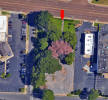 |
 |
|
Darnell Home |
1433 Entrance |
Aerial View |
Darnell
Home from Side |
|
|
|
|
|
|
|
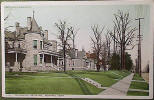 |
Union
Avenue was a desirable place to live in Memphis of the early
1900s. It was lined with large homes and grand mansions.
Rowland
Darnell had chosen to build his 15,813 Square Foot
Beaux-Arts-Colonial Revival Mansion at
1433 Union Avenue.
Today
it’s the last mansion standing. Next door is Taco Bell and
now the whole Union Avenue strip is home to fast food joints and
strip shopping centers. Nothing grand about that ... |
|
Vintage Union Ave
|
|
|
|
|
 |
 |
 |
 |
|
Vintage
Union Ave |
1906
Union Ave |
Vintage
Union Ave |
1908
Union Ave |
|
|
|
|
The
1910 Census shows that the entire Darnell family lived at the
1433 Union Avenue house:
Roland. his wife Matilda, sons Rowland H, Fred M, Harry A and Rezneat M,
Daughters Beatrice and Pauline. In addition the
family had 4 live-in servants. Rowland was pleasant company and was
very popular.
He belonged to Social Clubs but preferred quiet home life with his family. On occasion he did open
his home to friends and extended cordial welcomes and great
hospitality. He also was considered "big-hearted".
When the war broke in Europe, he made an offer to one of his friends
in Belgium to take care of his wife and two children until such time
as the war ended, paying all expenses himself. |
 |
| |
1910
Census |
|
|
|
|
|
|
|
|
Tragedy struck the Darnell family in 1911. Mrs. Darnell, Bernice,
and Pauline were visiting Freeport, Long Island. They and
a family friend were in a taxicab crossing the railroad tracks when
the cab was struck by the train,
instantly killing Mrs. Darnell
and Bernice and seriously injuring the other two occupants.
After a lengthy recuperation, Pauline did recover from the
accident. Rowland's father had died the year before in
1910. Five years later when he himself was "in the best of
health" and "...never felt better", he had a massive heart
attack and died. |
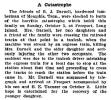 |
 |
| |
1911 Accident |
Obit |
|
|
|
|
|
|
|
|
|
|
Roland's will left the home, valued at $100,000, to the four
younger children, and $20,000 in cash to his oldest son, Rowland
- "... this solution was made with a view to keeping the younger
children together in the home as long as they desired to remain
there". Apparently the family remained in the house until
1916 when it was sold to the Nineteenth Century Club.
Rowland H. Darnell continued in the lumber business.
|
 |
 |
| |
1916 Will |
1922 Business |
|
|
|
 |
Darnell memorabilia doesn't often come up on the internet.
This 1906 envelope recently was available on Ebay. |
| 1906
Envelope |
|
|
|
|
|
|
|
|
|
|
|
|
|

Gayoso Hotel |
In
1890, a group of elite white women, led by Mrs. Clarence Selden, met at the Gayoso Hotel and
founded what was soon to become the largest and most influential
philanthropic women's club in Memphis. Its stated
objectives were "to promote the female intellect by encouraging
a spirit of research in literary fields and provide an
intellectual center for the women of Memphis." Although
men feared the club would interfere with their wife's duties, it
was a success from the start. For the first 4 years,
the club had rooms in various downtown buildings and in 1895 they
took a luxury suite or rooms on the 3rd floor of the Lyceum Theatre at 2nd and Jefferson.
By 1901 they had their first building at 174 3rd Street. (The number
changed to 178 N. 3rd in 1905). |
|
|
|
|
|
|
|
|
Membership
continued to rise and peaked in 1926 with approximately 1400
members. The membership focused on the needs of women and
children and they addressed problems in areas such as
sanitation, health, education, employment, and labor conditions.
They led the battle to have a police matron at the city jail,
and a female sanitary inspector at the Board of Health.
They also played an important role in bringing higher education
to Memphis. They were instrumental in initiating a "clean
government campaign" and demanding the ouster of corrupt
officeholders. They built the first public playground in
Memphis. |
 |
|
|
|
|
In
1926, the Nineteenth Century Club acquired the 15,813 square foot Darnell House.
The house was built in 1906 by Rowland J. Darnell, one of the
great lumber magnates when Memphis flourished as the lumber
capitol of the world. The mansion boasted some of the most
beautiful millwork in the south and still retains its original
floor plan and architectural details. It is the last of
its kind in Memphis and is literally a time-capsule, reflecting
a bygone era of the city's history.
|
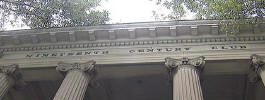
Nineteenth Century Club
|
|
|
|
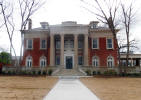 |
 |
 |
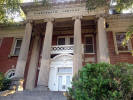 |
| Nineteenth
Century Club |
Nineteenth Century Club |
Nineteenth Century Club |
Nineteenth
Century Club |
|
|
|
|
And
the Nineteenth Century Club stayed here for the next 80 years.
But as maintenance costs mounted, the club, faced with dwindling
membership and limited funds, was forced to sell the property
because they simply couldn't afford to take
care of it. What followed was a two year court battle over
the fate of the historic house. The court battle included the
Nineteenth Century Club board members fighting among themselves, the
new property owners, and the Memphis Children's Museum. In
2013, the Union Group LLC, had acquired the property for $550,000
after the competitive bidding process. Proceeds from the sale
went to the Children's Museum of Memphis. That bequest didn't
please some former club members and preservationists. So
a lawsuit challened the sale claiming it violated the club's
bylaws.
|
|
|
 |
 |
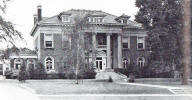 |
 |
| Nineteenth
Century Club |
Nineteenth Century Club |
Nineteenth Century Club |
Nineteenth
Century Club |
|
|
|
|
Eventually the sale was upheld and some demolition work was actually
begun. But the court battle began again going back and forth
...
demolition denied ... demolition certain. The fate was
eventually decided by the new owners - the Lin Family. They will not demolish the
old mansion. Instead they plan to keep the building's facade
and have consulted
an
architectural firm on plans for preserving the inside. It will
be turned into a restaurant and event space. As of July
15, 2015, the owners have
secured a $2.35 million construction loan and have pulled a
$2.17 million work permit. |
|
|
|
Although
the old Nineteenth Century Club remains in existence, after the sale of the Darnell House is
final and complete, they plan to eventually disband and simply fade away.
|
 |
| |
19th C. Club
vintage soup cup |
|
|
|
|
|
|
|
|
|
|
Ironically, in spite of the fame of the Darnell House, very
few actually knew what the interior was like. When the
building
appeared to be one step prior to demolition ,
interior photos began to show up on the internet. The best
of the interior photos are a series by Vance Lauderdale and Joe
Spake (below). |
 |
|
|
|
|
|
|
|
|
|
|
|
|
|
|
|
|
|
|
|
|
|
|
|
|
|
|
|
|
|
 |
As photos become available, a few will be
added to this space ... |
|
19th
Century Club - 2015 |
On January 1, 2017, the
upscale
IZAKAYA RESTAURANT opened in the newly renovated 19th
Century Club. It was not successful and the restaurant was
closed for a couple of months and then reopened in 2018 as
"Red Fish Sushi Asian Bistro". There will be photos later. |
|
|
|
|
|
|
|
|
|
|
|
|
Credits |
|
|
|
The
Historic-Memphis website does not intentionally post copyrighted
photos and material without permission or credit.
On
occasion a "non-credited" photo might possibly be posted because we
were unable to find a name to give credit. Because of the nature of
our non-commercial, non-profit, educational website, we strongly
believe that these photos would be considered "Fair Use. We have
certainly made no monetary gain, although those using this website
for historic or Genealogy research have certainly profited. If by
chance,
we have posted your copyrighted photo, please contact us, and we'll
remove it immediately, or we'll add your credit if that's your
choice. In the past, we have found that many photographers
volunteer to have their works included on these pages and we'll
also do that if you contact us with a photo that fits a particular
page. |
|
|
|
The "Historic-Memphis" website would like to acknowledge and thank the
following for their contributions which helped make this website
possible:
Memphis
Public Library, Memphis University Library, Memphis Law Library,
Memphis Commercial Appeal, Memphis Press Scimitar, Shelby County
Register of Deeds, Memphis City Schools, Memphis Business Men's
Club, Memphis Chamber of Commerce, Memphis City Park Commission,
Memphis Film Commission, Carnival Memphis, Memphis Historical
Railroad Page, Memphis Heritage Inc, Beale Street Historic District,
Cobblestone Historic District, Memphis Historic Districts, Vance
Lauderdale Family Archives, Tennessee State Archives, Library of
Congress, Kemmons Wilson Family, Richard S. Brashier, Lee Askew,
George Whitworth, Woody Savage and many individuals whose assistance is
acknowledged on the pages of their contributions. Special
thanks to Memphis Realtor, Joe Spake, for giving us carte blanche
access to his outstanding collection of contemporary Memphis photos.
We do not have high definition copies of the photos on these
pages. If anyone wishes to secure high definition photos,
you'll have to contact the photographer or the collector.
(To avoid any possibility of contributing to SPAM, we do not
maintain a file of email addresses for anyone who contacts us). |
|
|
|
|
|
|
|
|
|
|
|
|
|
|
|
|
|
|
|
|
|
|
| |
|
|